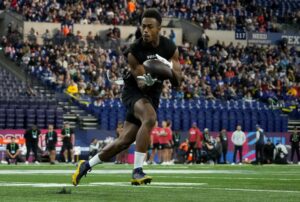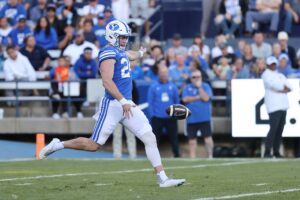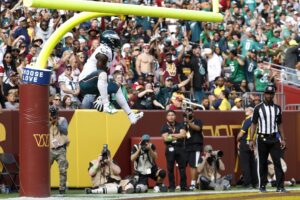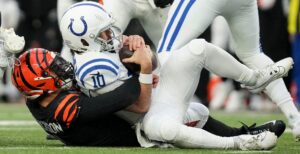Continuing through our newest series “The Breakdown,” we move to the NFC North and kick things off with the Detroit Lions schematic philosophy. Gun-slinging quarterback Matthew Stafford was a legitimate MVP candidate halfway through the 2016 season with arguably his most efficient career performance. Conversely, the defense regressed and was completely missing the requisite efficiency. Below is a look at what both sides of the ball employ.
The Breakdown: A Look at the Detroit Lions Schematic Philosophy
Offense
A Straight Forward Approach
Having spent the 2014 and 2015 seasons as Stafford’s quarterback coach, Jim Bob Cooter enters his third season as the team’s offensive coordinator. He utilizes basic formations with a very limited amount of pre-snap motion and movement to provide Stafford with a clearer picture of how defenses are trying to design their coverages. When there is constant movement before the snap, the defense is going to react in a similar manner as opposed to stationary targets that allow Stafford and the offense to decipher the defense’s intentions and potential rolls with improved clarity. Because of this, defenses will disguise potential blitzes and rolls with increased efficiency in an attempt to fool Stafford at the last second.
This ultimately creates a conundrum for the Lions and something of a double-edged sword. The number one and two receiving duo of Golden Tate and Marvin Jones, and overall dearth of talent continuously draw man coverage looks due to their inconsistencies with winning on iso-routes and Cooter’s lack of stack-releases, bunch formations and pre-snap motion.
While reliable targets, Tate and Jones are limited in their victories without the use of the aforementioned services. Such factors ultimately tie back into what Cooter asks of Stafford from a cerebral standpoint; that the former UGA quarterback properly deciphers the specific coverage beaters and remain on-schedule even if his receivers can’t. Expect 2017 third-round pick, receiver Kenny Golladay, to cement himself as the team’s number three option and play a vital role in their base 11 personnel.
Detroit incured a tremendous loss up front in the form of left tackle Taylor Decker‘s injury that forced them to trade for former first round flame out, Greg Robinson. The additions of guard T.J. Lang and tackle Ricky Wagner along the right side of the line solidify a very talented line when Decker is healthy. And Cooter’s heavy reliance on his one-back running game is a direct extension of both their base personnel and the fact that starting running back Ameer Abdullah is a cut-and-go slasher with the improvisational skills to create opportunities for himself.
The likes of screens, bubbles and misdirections are all extensions of a run game that struggled mightily last season, but should theoretically improve as a result of the contributions made up front. The additions of tight ends Darren Fells and Michael Roberts will also aid the use of 12 personnel, their second-most popular, while fellow backs Zach Zenner and Theo Riddick create a three-headed monster with varying skillsets that will force opposing defenses to try to be ready for a litany of options.
Defense
Working from Two-High
Defensive coordinator Teryl Austin is entering his fourth season at the position and looks to continue the use of his split-safety defense. I’ve already touched upon how inefficient this unit was as a whole this past season, but there is more to be said about just how poor the unit was against the pass. The entire linebacking corps forced just a single turnover (no interceptions), while the team’s ten picks finished tied in the league at 23rd. It should come as no surprise, then, that Detroit spent six of their nine picks in last April’s draft on the defensive side of the ball, headlined by first-round linebacker Jarrad Davis. Fellow linebacker Jalen Reeves-Maybin went in the fourth, while second and fifth-round picks were spent on cornerbacks Jalen Tabor and Jamal Agnew, respectively.
The reliance on two safeties naturally caps the level of creativity Austin can incorporate into his blitz packages. Austin’s ability to successfully disguise his few pressure looks and maintain both their effectiveness and integrity from such two-high looks is important. Detroit’s construction of their defensive line is aptly suited to Austin’s desire to send four-man rushes with stunts and twists woven in. Anthony Zettel isn’t the athletic, mobile edge rusher capable of flirting with or surpassing double-digit sacks like Ziggy Ansah, but he’s flashed as a defender who can generate consistent pressure. And the interior combination of A’Shawn Robinson and Haloti Ngata creates two mobile pressure-cookers who can make life miserable on the quarterback with their ability to squeeze the middle of the pocket and utilize their lateral movement skills to draw open looks for their fellow down linemen in their pass-rush games.
Corner Darius Slay has evolved into a true number one defensive back, but the Lions are missing someone of equal (or at least close to) reliance opposite him. Quandre Diggs‘ noticeably inconsistent play in the slot last season prompted the Lions to go get former Oakland Raiders corner D.J. Hayden and have the two split time, while Tabor is expected to compete with Nevin Lawson for those number two reps opposite Slay. Nevertheless, Detroit needs improved play from their secondary to boost their blitz packages with effective man coverage behind them, and this is what they sought to address with the multiple moves made in the off-season.
Without question, the safeties are the most important players in the Lions defense. Detroit drafted Miles Killebrew for his run-stopping skills in the box and paired him with the combination of Glover Quin and Tavon Wilson. That trio supports their use of their nickel packages and base two-high shell. Killebrew was frequently on the field in blitz and early-down packages, but the additions made at cornerback suggest he will see fewer snaps in such nickel packages. Austin employs a number of single-high looks that capitalize on Quin’s skills as a centerfielder. But as previously mentioned, it’s imperative that Wilson continues to show he can work from both spots in order for Austin’s two-safety defense to thrive in both base and pressure packages.
Last Word
Those teams who are battling for second behind the Green Bay Packers in the NFC North are entrenched in a tough battle, but it will likely come down to the Lions and the Vikings. It seems unrealistic to predict the Bears will surpass six wins with either Mike Glennon or Mitchell Trubisky as their starting quarterback. However, the Vikings themselves have a decision to make at quarterback if Teddy Bridgewater meets his recovery timetable and the team feels comfortable putting him back out in the action. The Lions offense isn’t expected to miss a beat, so if they want to challenge the Packers for that top spot or at least secure a Wild Card birth, the defense must shoulder more responsibility.






